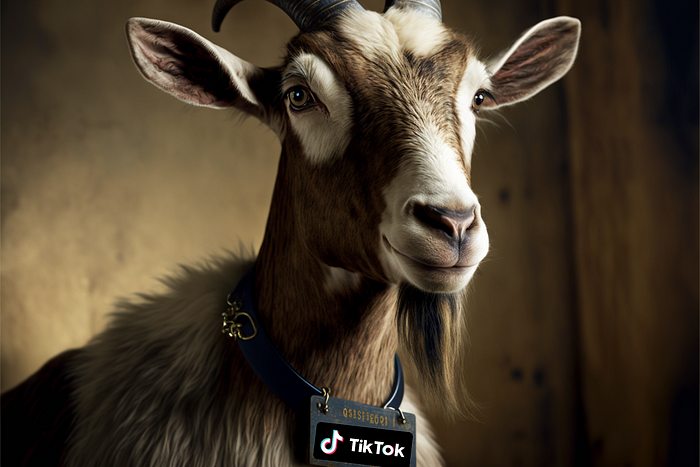01/11/2023
Enterprise
For Startup Growth, TikTok is the GOAT 🐐
But that doesn’t mean you’ve found product market fit.

I’m about 4 months into my job as a partner at Lightspeed after 15 years building products (including Anchor, which I co-founded and then sold to Spotify) and angel investing in 50+ startups. But while I’m still new to the job, I’ve already noticed a number of interesting trends throughout the hundreds of startup pitches I’ve been lucky enough to participate in, including early stage teams’ approach to growth. Like in most other areas of the economy, the recent downturn has affected startups’ spending habits, and as a result, teams are finding new and creative ways to grow their products.
However, one tactic that seems consistent across virtually every growth strategy I’ve come across is startups’ heavy reliance on TikTok as a (or the) key driver of user acquisition. But just because a startup is forgoing paid user acquisition in lieu of TikTok, it doesn’t mean that startup has found product-market fit.
TikTok is the 🐐
It’s no surprise why startups are leveraging the superpower that is TikTok. After all, it is insanely effective at driving highly targeted distribution of content. So much so, that even the world’s biggest social networks are abandoning social graph distribution in favor of TikTok-inspired algorithmic distribution (aka “recommendation media”, which I’ve written about extensively here). So it’s no wonder that companies of all shapes and sizes — including startups — would rely on TikTok’s engine to find customers for their products. TikTok can find an audience for pretty much anything. So if you make enough videos with the right mix of content and metadata, you have a pretty good chance at getting hundreds, thousands, or even millions of impressions on your marketing message. Given all of the above, TikTok may be the greatest startup growth engine of all time.
Product Market Fit (PMF) and ways to grow
If you’re building an early stage startup, you’ve no doubt heard the term “product market fit” (or PMF). While there are many definitions for this term, I appreciate Paul Graham’s simple explanation that “Product-Market fit is when you build something that people want.” When your product finds PMF, it often starts growing “organically” because the people who want what you’ve built start organically telling other people about it. This word of mouth dynamic can be really effective at helping a product grow, especially if the product itself helps accelerate it through built-in sharing, multiplayer product dynamics, and other product-led growth tactics. I would personally consider any type of growth that’s gained as a result of finding PMF to be organic.
However, finding PMF is really hard, and oftentimes, startups want to grow before they’ve actually found PMF. This can be for any number of reasons. For example: a team wants to have a critical mass of users to experiment with (to find PMF), they want to kickstart more organic growth flywheels, or they may want their product to appear to be growing faster than it actually is. I would classify this as inorganic growth. Historically speaking, the primary way to drive inorganic growth has been by paying for it through paid user acquisition, often via search ads on Google or the App Store), paid social media marketing (on Facebook or Instagram), PR, or influencer marketing (paying influencers directly to talk about your product), just to name a few. The main thing that all of these tactics have in common is that they cost a lot of money if they are to be effective. In fact, they’re often so expensive that they can dramatically reduce a startup’s runway.
There’s never been anything like TikTok
Before TikTok, it wasn’t really possible for a startup to say that they had organic growth (or more accurately that they weren’t paying for growth) if they didn’t actually have PMF. This is because there simply weren’t any truly scaled channels (such as the ones mentioned above) to find growth without paying for it.
But then TikTok came along and changed the startup growth game. Through TikTok’s perfect recommendation media engine and their massive / crazy-engaged user base, startups can now actually find truly scaled growth for their product without actually spending money on paid media, PR, influencer marketing. The result? Being able to declare that a startup has found the ever elusive, unpaid “organic growth” that is most typically associated with PMF.
Now, don’t get me wrong: this is great, and I seriously wish we had access to such a ridiculously effective tool when we were building Anchor. It would have saved us a lot of time spent manually curating Twitter Moments. Leveraging TikTok to find users means many of today’s startups can forgo spending precious capital normally spent on paid user acquisition, thus extending their runway.
But this is not organic growth. Just because a startup isn’t spending money on paid user acquisition doesn’t mean that startup has found product-market fit.
All of the paid user acquisition channels noted above are never referred to as “organic”. This is because the distribution of that startup’s marketing message through paid user acquisition has nothing to do with whether or not people actually adopt a product and choose to share it organically. By that same standard, growth on TikTok which is the result of a highly optimized content strategy that leverages the best recommendation engine to ever exist should probably also not be considered organic, even if it results in a flood of new users. TikTok may be really great at finding users to deliver targeted content, but that doesn’t mean those users will actually get value out of the product itself such that they’d share it on their own organically. Adoption is not the same thing as engagement, or more importantly, retention.
Platform giveth, Platform taketh
Bottom line: being able to leverage TikTok — the GOAT — to drive growth for your product instead of paid user acquisition is not indicative of a strong business or product market fit. And perhaps most importantly, this magical distribution channel can vanish at any time. After all, if the platform giveth, then the platform can just as easily taketh away (just ask Kylie Jenner, who famously appealed to Instagram’s Adam Mosseri after announcing the company’s shift away from friend graphs and towards recommendation media, thus devaluing her 360M+ followers).
In the meantime, it’s important for both startups and investors alike to recognize this unique tactic and moment in time and set TikTok-led growth aside for what it is: a beautiful gift from the platform gods… but definitely not product-market fit. Instead, my recommendation for early stage startups would be to tap the TikTok superpower while the gettin’ is good, but above all else, iterate relentlessly on product until you’ve found PMF. That’s the real superpower.
Authors



